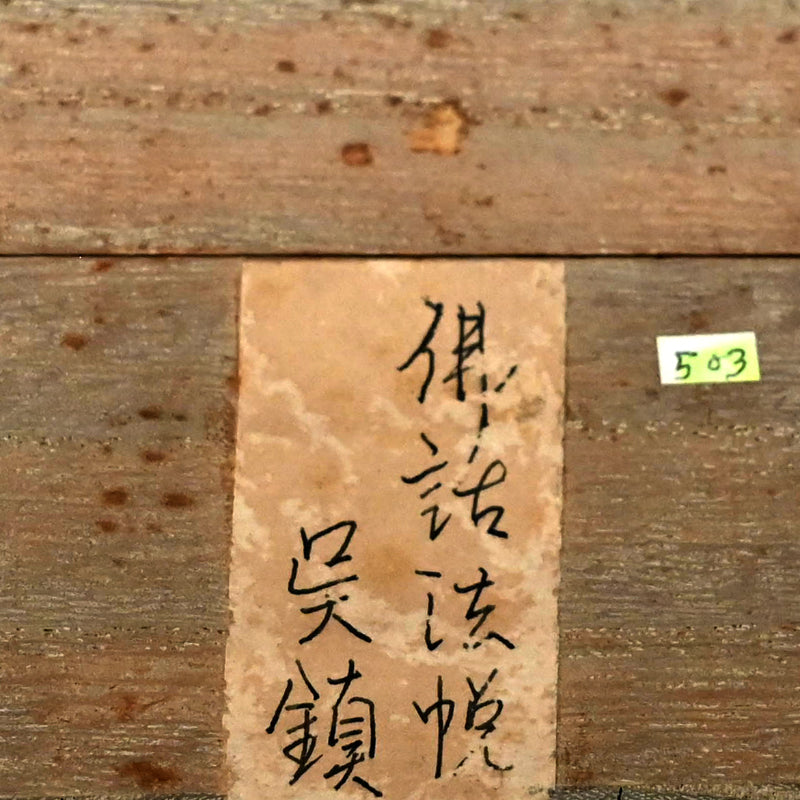Hermitage on the Mountain Path ー福田 古道人 “山道幽居図”
Hermitage on the Mountain Path ー福田 古道人 “山道幽居図”
Item Code: 古14
Couldn't load pickup availability
In this unusually spare and vertical composition, Fukuda Kodojin reduces the landscape to its most essential gesture: a winding mountain path that slips upward into seclusion, terminating in the faint shelter of a thatched pavilion tucked among high crags. The work reads less as geographical description than as state of mind—a visual correlative to poetic reclusion. The road, rendered in a broken sequence of short, pulsing strokes, is less traveled way than rhythm of thought. Trees and rocks appear as abbreviated forms, executed with broad, breathing sweeps of the brush that dissolve as quickly as they emerge. Unlike many traditional bunjinga landscapes that locate the viewer in a distant observational vantage, this scroll positions us on the path itself, walking toward retreat rather than merely regarding it. The implied solitude is gentle, not remote: the pavilion suggests refuge, not exile. The painting becomes a meditation on the inward journey—the slow ascendance from the world of entanglement toward a cultivated quietude. The inscription, though vigorously cursive and nearly abstracted, strengthens this tone of fugitive lyricism: rather than a caption, it behaves as a drifting extension of the landscape—ink that breathes as weather more than words. Kodōjin allows writing and painting to fold into one another, the calligraphic line becoming another contour in the terrain of withdrawal. Ink on paper in rough olive silk with ceramic rollers. It is 44.5 x 191 cm (18 x 75 inches) and in fine condition.
A possible reading of the poem is:
A secluded dwelling in the mountains:
the clouds drift freely, with no intent of their own,
and the flowers bloom untouched, unstained by lesser growth.
But ordinary men are quick to chase after such purity,
not realizing that striving for it is no Dharma at all.
Fukuda Kodojin (1865-1944) was an eccentric self-taught artist, his status as a poet, calligrapher and literati artist has reached legendary status. Born at a time of great change (4 years before the final fall of the Edo Government), he lived through the westernization of Meiji, Taisho Democracy, the rise of Imperialism and final defeat of the Showa eras. He was part of a small group of artists existing outside conventional circles in pre-war Japan. He moved to a village outside of Kyoto in 1901, where he supported himself and his family by privately tutoring those who wished to learn Chinese-style poetry. Kodojin was simply a scholar. His poetry, painting, and calligraphy all stem from a life-long cultivation of the mind. He was said to have taken the time just before his death to destroy the large portion of his own remaining work, leaving only that which must have met some personal criteria. Kodōjin’s paintings and calligraphy survive mainly in private collections, but significant works can be found in the collections of the British Museum, Freer Sackler Gallery of the Smithsonian Institute, Honolulu Museum of Art, Houston Museum of Fine Arts, Kumamoto Prefectural Museum of Art, Minneapolis Institute of Art, Museo Kaluz, New York Metropolitan Museum of Art, Portland Art Museum, Seattle Art Museum, St. Louis Art Museum, Tanabe City Museum of Art and Wakayama Prefectural Museum of Art among others including such well known Private collections as the Cowles Collection, Hakutakuan Collection, Manyoan Collection and Welch Collection. Twenty five paintings by the artist formed a private exhibition (from the Gitter-Yelen collection) at the New Orleans Museum of Art in 2000. In recent years, exhibitions such as The Last Master of the Literati Tradition: Fukuda Kodōjin (Minneapolis Institute of Art, 2023) have brought renewed attention to his achievement. For more on his life see the book Old Taoist, or Unexplored Avenues of Japanese Painting.
Share






























